Articles
- Page Path
- HOME > Korean J Community Nutr > Volume 17(4); 2012 > Article
-
Original Article
- Evaluation of Nutrient Intake and Anthropometric Parameters related to Obesity in Korean Female Adolescents according to Dietary Diversity Score: From the Korean National Health and Nutrition Examination Surveys, 2007-2009
- Yun-Jung Bae
-
Korean Journal of Community Nutrition 2012;17(4):419-428.
DOI: https://doi.org/10.5720/kjcn.2012.17.4.419
Published online: August 31, 2012
Department of Food and Nutritional Sciences, Hanbuk University, Gyeonggi, Korea.
- Corresponding author: Yun Jung Bae, Hanbuk University, 233-1 Sangpae-dong, Dongducheon-si, Gyeonggi-do 483-120, Korea. Tel: (031) 860-1445, Fax: (031) 860-1449, byj@hanbuk.ac.kr
Copyright © 2012 The Korean Society of Community Nutrition
- 1,013 Views
- 2 Download
- 11 Crossref
Figure & Data
REFERENCES
Citations

- Evaluation of Dietary Nutrient Intake and Food Variety by Milk Consumption in Postmenopausal Korean Women: Data Based on the Korea National Health and Nutrition Examination Survey 2013~2015
Ae Wha Ha, Woo Kyung Kim, Sun Hyo Kim
Journal of the Korean Society of Food Science and Nutrition.2022; 51(9): 912. CrossRef - Relationship between dietary diversity score and general health in female students
Azadeh AMINIANFAR, Fereydoun SIASSI, Mostafa QORBANI, Javad KARIMI, Gity SOTOUDEH, Yas KALIKIAS, Sanaz SOLTANI
Minerva Pediatrics.2021;[Epub] CrossRef - Index of Nutritional Quality (INQ) and the Risk of Obesity in Male Adolescents: a Case-Control Study
Maryam Gholamalizadeh, Samira Rastgoo, Saeid Doaei, Farhad Vahid, Hanieh Malmir, Narges Ashoori, Alireza Mosavi Jarrahi
Biological Trace Element Research.2021; 199(5): 1701. CrossRef - Relationship between dietary intakes and the double burden of malnutrition in adults of Malang, Indonesia: An exploratory study
Soo Jin Lee, Ho Kyung Ryu
Nutrition Research and Practice.2018; 12(5): 426. CrossRef - Night eating status according to body mass index of Korean adolescents
Mi-Kyeong Choi, Yu-Jin Cho, Myung-Hee Kim, Yun Jung Bae
Nutrition & Food Science.2017; 47(1): 89. CrossRef - Systematic Review on the Study of the Childhood and Adolescent Obesity in Korea: Dietary Risk Factors
Eun Jeong Heo, Jae Eun Shim, Eun Young Yoon
Korean Journal of Community Nutrition.2017; 22(3): 191. CrossRef - Development of NQ-A, Nutrition Quotient for Korean Adolescents, to assess dietary quality and food behavior
Hye-Young Kim, Jung-Sug Lee, Ji-Yun Hwang, Sehyug Kwon, Hae Rang Chung, Tong-Kyung Kwak, Myung-Hee Kang, Young-Sun Choi
Journal of Nutrition and Health.2017; 50(2): 142. CrossRef - Comparison of Diet Quality and Diversity according to Obesity Type among 19-64 year old Korean Adults
Hyae Min Gu, So Yeon Ryu, Jong Park, Mi Ah Han, Yeong Eun Son
Korean Journal of Community Nutrition.2016; 21(6): 545. CrossRef - Effects of brown rice-vegetable school meal program on subjective health status, BMI and hematological parameters among high school students
Kyoung-Ja Moon, Hye-Young Kim
Journal of the Korea Academia-Industrial cooperation Society.2015; 16(11): 7385. CrossRef - Evaluation of the Nutritional Value of Traditional Korean Noodles through Energy Density and Diversity
YoonKyoung Yang, SungOk Kim, Juhyeon Kim
The Korean Journal of Food And Nutrition.2014; 27(4): 732. CrossRef - Effects of a Brown Rice and Vegetable Diet on the Defecation Conditions and Health Status of High School Students
Hye Young Kim
Journal of Korean Public Health Nursing.2013; 27(1): 179. CrossRef
- Figure
- We recommend
- Related articles
-
- Trends in growth and nutritional status of Korean toddlers and preschoolers: a cross-sectional study using 2010–2021 Korea National Health and Nutrition Examination Survey data
- Biochemical characteristics, nutrient intakes, and chronic disease risk according to the dietary fat energy ratio in middle-aged Korean: a cross-sectional study using data from the 7th (2016–2018) Korean National Health and Nutrition Examination Survey
- Total sugar intake and its contributed foods by age groups in Koreans using the 8th (2019–2021) Korea National Health and Nutrition Examination Survey: a cross-sectional study
- Comparative study on the health and dietary habits of Korean male and female adults before and after the coronavirus disease 2019 pandemic: utilizing data from the 8th Korea National Health and Nutrition Examination Survey (2019–2021)
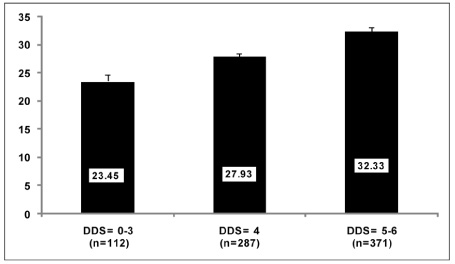
Fig. 1
General characteristics of the subjects
1) Mean ± SE (Means with different superscript letters are significantly different from each other by Tukey's test.)
All variables have been age-adjusted expect age.
Dietary intakes of the subjects
1) Mean ± SE (Means with different superscript letters are significantly different from each other by Tukey's test.)
All variables have been age-adjusted.
The percent of RNI1) of the subjects
1) Recommend Nutrient Intake
2) Estimated Energy Requirement was used
3) Mean ± SE (Means with different superscript letters are significantly different from each other by Tukey's test.)
All variables have been age-adjusted.
The percent of the subjects consumed under EAR1) of the subjects
1) Estimated Average Requirement
2) Significance as determined by χ2-test
3) Estimated Energy Requirement was used
4) %
Index of Nutritional Quality (INQ) of the subjects
1) Mean ± SE (Means with different superscript letters are significantly different from each other by Tukey's test.)
All variables have been age-adjusted.
Food intakes from each food group in subjects (g/day)
1) Mean ± SE (Means with different superscript letters are significantly different from each other by Tukey's test.)
All variables have been age-adjusted.
Distribution of food group intake pattern (CMDFVO)1) of the subjects
1) CMDFVO: cereals, meats, dairys, fruits, vegetables, fats and oils food group
1: food group(s) present, 0: food group(s) absent
For example, CMDFVO = 111111 denotes that all food group (cereals, meats, dairys, fruits, vegetables, fats and oils food group) were consumed
1) Mean ± SE (Means with different superscript letters are significantly different from each other by Tukey's test.) All variables have been age-adjusted expect age.
1) Mean ± SE (Means with different superscript letters are significantly different from each other by Tukey's test.) All variables have been age-adjusted.
1) Recommend Nutrient Intake 2) Estimated Energy Requirement was used 3) Mean ± SE (Means with different superscript letters are significantly different from each other by Tukey's test.) All variables have been age-adjusted.
1) Estimated Average Requirement 2) Significance as determined by χ2-test 3) Estimated Energy Requirement was used 4) %
1) Mean ± SE (Means with different superscript letters are significantly different from each other by Tukey's test.) All variables have been age-adjusted.
1) Mean ± SE (Means with different superscript letters are significantly different from each other by Tukey's test.) All variables have been age-adjusted.
1) CMDFVO: cereals, meats, dairys, fruits, vegetables, fats and oils food group 1: food group(s) present, 0: food group(s) absent For example, CMDFVO = 111111 denotes that all food group (cereals, meats, dairys, fruits, vegetables, fats and oils food group) were consumed

 KSCN
KSCN


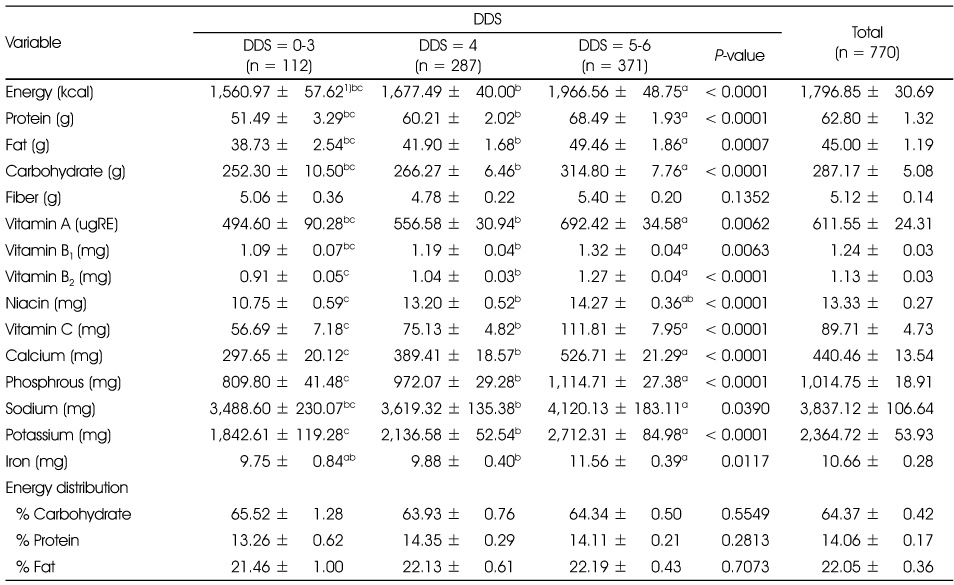
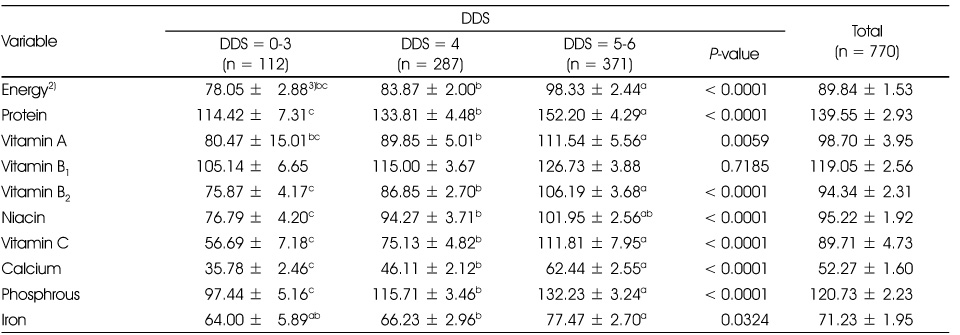
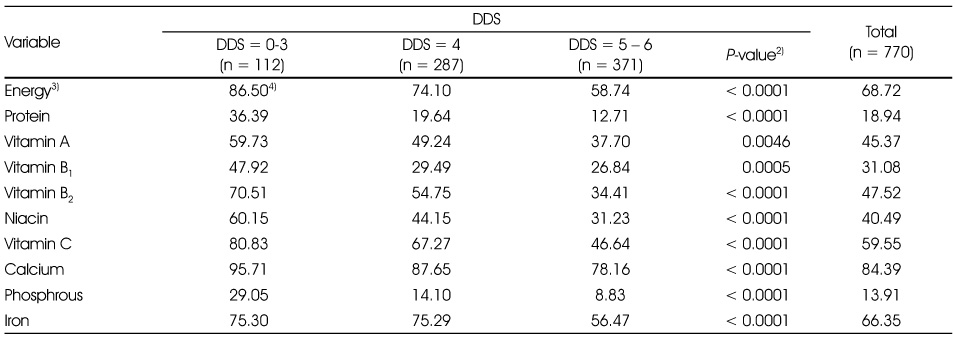
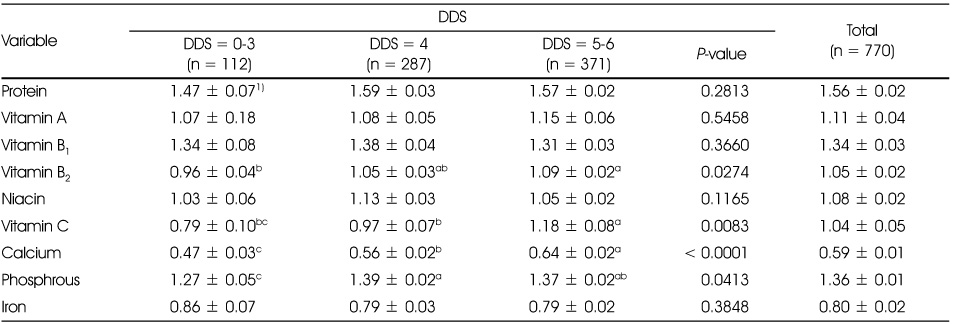
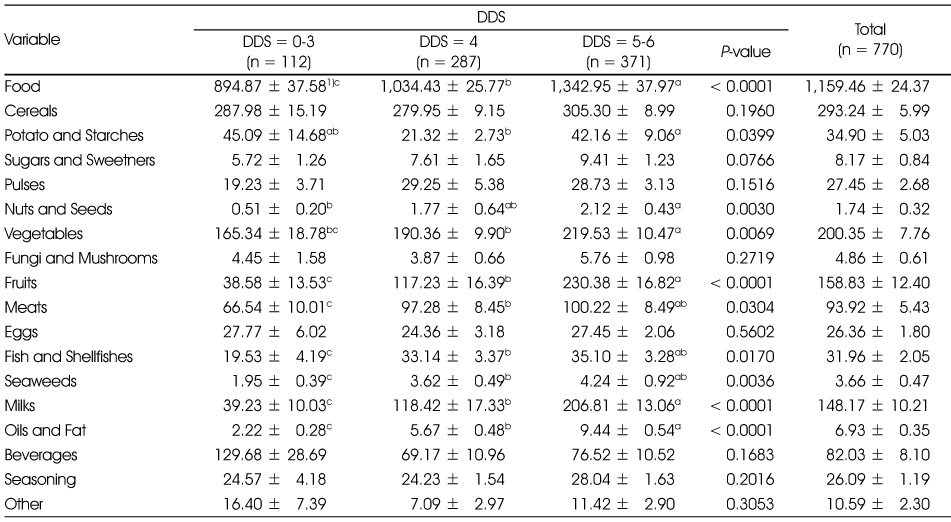

 Cite
Cite


